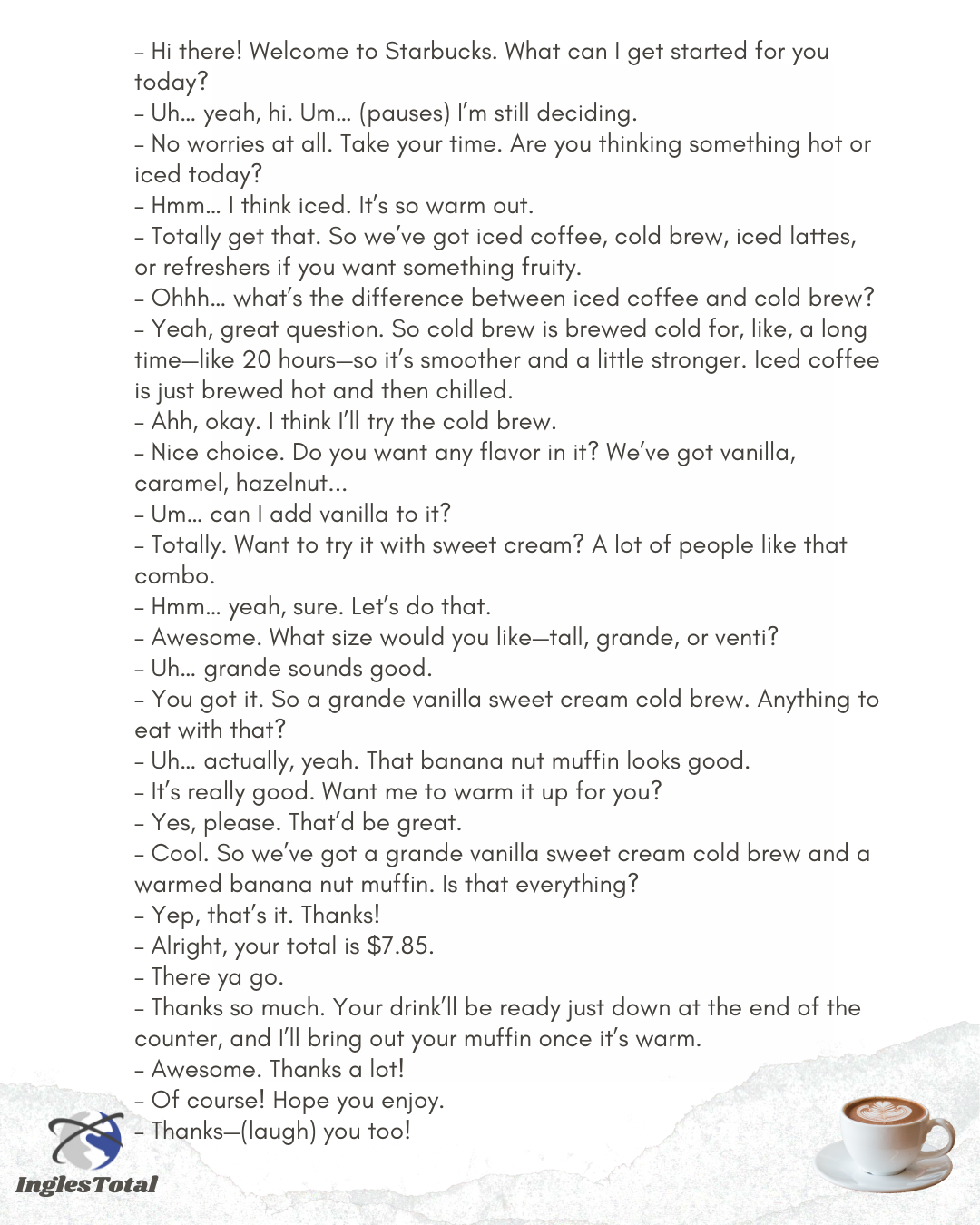Como pedir algo en Starbucks en Ingles
Como pedir algo en Starbucks en Inglés – SECCION: Conversation / Speaking Activity – Clases de conversación #49
Welcome to InglesTotal,
Podcast: Download
Subscribe: Apple Podcasts | Spotify | TuneIn | RSS
Hoy tenemos una nueva publicación en nuestra sección y curso de Speaking o conversación en inglés. Hoy les invitamos a practicar listening con una conversación en STARBUCK CAFE. Para poder ver todas nuestras lecciones hasta la fecha en esta sección pueden ir a ESTE VINCULO.
Esta clase escrita viene acompañada de un audio que pueden encontrar al comienzo de esta publicación. Tampoco olviden de seguir redes sociales en Facebook y Twitter para más información de nuestros cursos gratis y sigan. Nuestros audios están en SPOTIFY (enlace aquí) y los que quieran compararme un café o donar para que esta pagina siga adelante pueden hacerlo usando este vinculo.
Learn Real English at Starbucks: A Listening Class for Everyday Conversation
Ordering coffee might seem simple, but it’s actually a great opportunity to practice real, conversational English! In this lesson, we’ll hear natural interaction between a customer and a barista at Starbucks. You’ll hear common expressions, polite phrases, and friendly small talk—exactly the kind of English native speakers use every day.
We’ll guide you line by line through the conversation, explaining vocabulary, grammar, and pronunciation along the way. Whether you’re just starting out or looking to improve your listening and speaking skills, this is the kind of English that helps you feel more confident in real situations like ordering food, asking questions, or just making small talk.
Ready to feel more at home the next time you’re in a café? Let’s get started!
Conversation at STARBUCKS

Conversation Analysis
Let’s now analyze this conversation. Remember that the audio of the conversation is at the beginning of this post.
Hi there! Welcome to Starbucks. What can I get started for you today?
💬 Polite greeting + service question. “What can I get started for you” is a common way baristas ask for your order.
🔄 Alternatives:
-
“What would you like today?”
-
“What can I get for you?”
📘 “Can I get” is a polite request. Present simple question form.
Uh… yeah, hi. Um… (pauses) I’m still deciding.
💬 Natural hesitation and filler words (“uh,” “um”) show thinking time. “I’m still deciding” means the person hasn’t chosen yet.
🔄 Alternatives:
-
“Give me a second.”
-
“I haven’t made up my mind yet.”
📘 Present continuous for an action happening right now: “I’m still deciding.”
No worries at all. Take your time. Are you thinking something hot or iced today?
💬 Polite reassurance and follow-up question to help the customer decide.
🔄 Alternatives:
-
“No rush!”
-
“Would you prefer something hot or cold?”
📘 Present continuous: “Are you thinking…” = a polite way to ask about a current preference.
Hmm… I think iced. It’s so warm out.
💬 Expressing a preference based on the weather.
🔄 Alternatives:
-
“Let’s go with iced.”
-
“Cold sounds better today.”
📘 Present simple: “I think” (mental state). “It’s” = “It is” (present simple for weather).
Totally get that. So we’ve got iced coffee, cold brew, iced lattes, or refreshers if you want something fruity.
💬 Barista expresses understanding + lists drink options. “Totally get that” = “I understand.”
🔄 Alternatives:
-
“Makes sense.”
-
“We have a few options…”
📘 “We’ve got” = contraction of “we have got” (present perfect, informal = present simple use).
Ohhh… what’s the difference between iced coffee and cold brew?
💬 Asking for clarification.
🔄 Alternatives:
-
“How are they different?”
-
“What’s the difference?”
📘 “What’s” = “What is” (present simple question).
Yeah, great question. So cold brew is brewed cold for, like, a long time—like 20 hours—so it’s smoother and a little stronger. Iced coffee is just brewed hot and then chilled.
💬 Explanation with casual phrases like “like” and “a little.”
🔄 Alternative explanation:
-
“Cold brew takes longer and tastes smoother. Iced coffee is just regular coffee with ice.”
📘 Present simple used for facts and descriptions.
Ahh, okay. I think I’ll try the cold brew.
💬 Shows decision-making. “I think I’ll…” is a common way to express a decision in the moment.
🔄 Alternatives:
-
“Let’s go with the cold brew.”
-
“I’ll take the cold brew.”
📘 “I think I’ll” = future intention with “will.”
Nice choice. Do you want any flavor in it? We’ve got vanilla, caramel, hazelnut…
💬 Positive feedback + upselling. “Do you want…” is a polite offer.
🔄 Alternatives:
-
“Would you like to add a flavor?”
-
“Any flavors you’d like?”
📘 Present simple question. “We’ve got” = informal for “we have.”
Um… can I add vanilla to it?
💬 Polite request. “Can I…” is a standard way to ask in cafés.
🔄 Alternatives:
-
“Could you add vanilla, please?”
-
“I’d like vanilla in that.”
📘 “Can I” = present simple question form.
Totally. Want to try it with sweet cream? A lot of people like that combo.
💬 Friendly suggestion + social proof. “Combo” = short for combination.
🔄 Alternatives:
-
“How about adding sweet cream?”
-
“People love it with sweet cream.”
📘 “Want to…” = informal present simple question (subject “you” is dropped).
Hmm… yeah, sure. Let’s do that.
💬 Agreeing with the suggestion. “Let’s” = “Let us” — common when making a shared decision.
🔄 Alternatives:
-
“Okay, sounds good.”
-
“Yeah, I’ll go with that.”
📘 “Let’s” = imperative form + “do” (base verb).
Awesome. What size would you like—tall, grande, or venti?
💬 Common Starbucks sizing options.
🔄 Alternatives:
-
“Which size do you want?”
-
“Small, medium, or large?”
📘 “Would you like…” = polite question, conditional modal.
Uh (break) grande sounds good.
💬 Customer selects the size. “Sounds good” = informal way of saying “I choose that.”
🔄 Alternatives:
-
“I’ll take a grande.”
-
“Let’s go with grande.”
📘 “Sounds good” = present simple (it sounds good).
You got it (breath). So a grande vanilla sweet cream cold brew. Anything to eat with that?
💬 Confirming the order and offering food. “You got it” = casual confirmation.
🔄 Alternatives:
-
“Coming right up.”
-
“Would you like a snack with that?”
📘 “Anything to eat” = present simple yes/no question.
Uh… actually, yeah. That banana nut muffin looks good.
💬 Spontaneous decision. “Actually, yeah…” is common when changing your mind.
🔄 Alternatives:
-
“I’ll take that muffin.”
-
“That one looks good.”
📘 Present simple: “looks good” = appearance right now.
It’s really good. Want me to warm it up for you?
💬 Friendly recommendation. “Want me to…” is informal.
🔄 Alternatives:
-
“Would you like me to heat it up?”
-
“I can warm it up if you want.”
📘 “Want me to…” = informal structure; “me” as the subject of the second action.
Yes, please. That’d be great.
💬 Polite agreement. “That’d” = “that would.”
🔄 Alternatives:
-
“Sure, thanks!”
-
“Yes, I’d like that.”
📘 “Would be” = conditional structure.
Cool. So we’ve got a grande vanilla sweet cream cold brew and a warmed banana nut muffin. Is that everything?
💬 Order recap + final check. Standard closing question.
🔄 Alternatives:
-
“Is that all for today?”
-
“Anything else for you?”
📘 “We’ve got” = informal “we have.” Present perfect used informally as simple present.
Yep, that’s it. Thanks!
💬 Customer confirms the order is complete.
🔄 Alternatives:
-
“That’s all.”
-
“Nope, I’m good. Thanks.”
📘 “That’s it” = “that is it” — present simple.
Alright, your total is $7.85.
💬 Final price given.
🔄 Alternatives:
-
“That’ll be $7.85.”
-
“Your total comes to $7.85.”
📘 Present simple to state cost.
There ya go.
💬 Said while handing the card or money. “Ya” = informal for “you.”
🔄 Alternatives:
-
“Here you go.”
-
“All set.”
📘 Informal phrase, no tense — conversational filler.
Thanks so much. Your drink’ll be ready just down at the end of the counter, and I’ll bring out your muffin once it’s warm.
💬 Post-payment info. “Drink’ll” = “drink will.”
🔄 Alternatives:
-
“You can pick up your drink over there.”
-
“I’ll bring the muffin out in a bit.”
📘 “Will be ready” = future tense for something happening soon.
Awesome. Thanks a lot!
💬 Casual appreciation.
🔄 Alternatives:
-
“Great, thank you!”
-
“Thanks, I appreciate it.”
📘 No specific tense — conversational response.
Of course! Hope you enjoy.
💬 Polite goodbye + good wishes.
🔄 Alternatives:
-
“You’re welcome! Enjoy your drink.”
-
“No problem. Have a great one!”
📘 Present simple used to express good wishes.
Thanks—(laugh) you too!
💬 Reciprocating the polite phrase.
🔄 Alternatives:
-
“Thanks, same to you!”
-
“You too, thanks again!”
📘 “You too” = “I wish the same to you.”
Básico | Pre intermedio | Intermedio (nuevo) |Clases de Conversación | Lectura | Pronunciación |Material y Recursos | Vocabulary



Leave a Reply